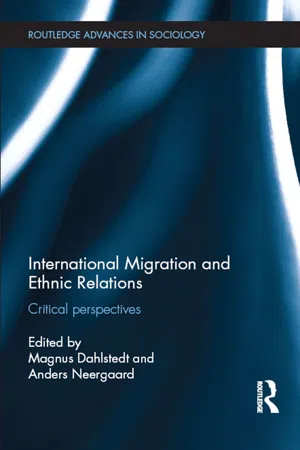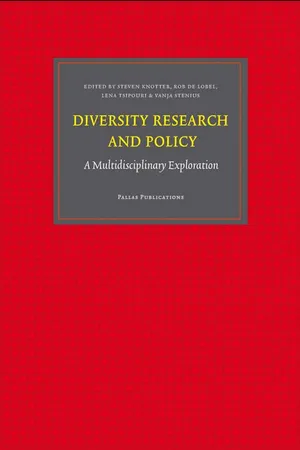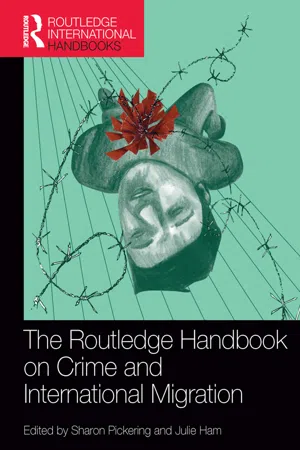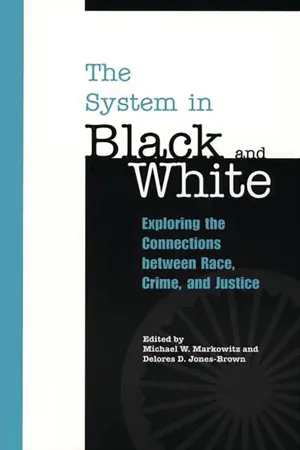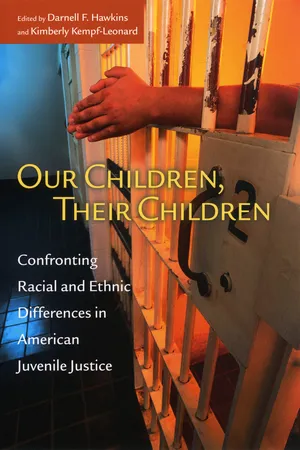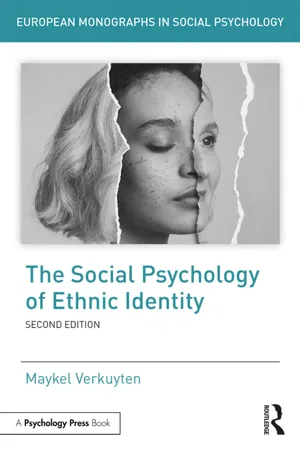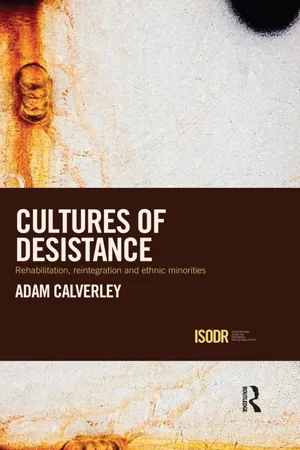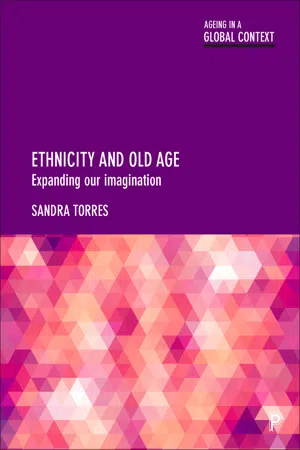Social Sciences
Ethnicity and Crime
Ethnicity and crime refers to the relationship between a person's ethnic background and their involvement in criminal activities. It explores how factors such as discrimination, socioeconomic status, and cultural influences may contribute to variations in crime rates among different ethnic groups. Research in this area aims to understand the complex interplay of social, economic, and cultural factors in shaping patterns of criminal behavior within diverse communities.
Written by Perlego with AI-assistance
Related key terms
1 of 5
10 Key excerpts on "Ethnicity and Crime"
- eBook - ePub
International Migration and Ethnic Relations
Critical Perspectives
- Magnus Dahlstedt, Anders Neergaard(Authors)
- 2015(Publication Date)
- Routledge(Publisher)
Ethnicity as a concept in the social sciences is often connected with global economic and political processes and tensions as well as with the new social movements and forms of resistance that emerged in the context of the anti-colonial liberation struggle. International migration has contributed to the wider use of the concept; the relations between majorities and minorities in the countries of immigration have become increasingly interpreted in ethnic terms, both in Sweden and internationally. This trend has been apparent since the 1970s. As early as 1975, Nathan Glazer and Daniel P. Moynihan could declare that there was a new reality requiring new concepts which reflected the changes in the world. ‘The new word is “ethnicity” and the new usage is the steady expansion of the term “ethnic group” from minority and marginal subgroups at the edges of society… to major elements of a society’ (Glazer and Moynihan 1975: 5). Since that time, ethnicity has come to be used in studies of migration and relationships between new ethnic minorities and majorities. Key issues became more directed towards how ethnicity is made visible, how it becomes expressed, how it connects in time and space and how it becomes linked to the social, economic and cultural conditions of a specific national context.In contemporary research the concept of ethnicity has been used in studies on migration and the processes of social inclusion and exclusion. In the meantime ethnicity has extended its embrace to research on social and cultural relations between majorities and minorities, as well as to the regulation of cultural pluralism in multicultural societies. Parallels have been drawn between ethnicity and race bringing the social construction of ethnicity (like race) into focus. Ethnicity, Hall (1992: 255) writes, is ‘constantly crossed and re-crossed’ with other social categories like race, class and gender. The concept of identity is defined as ‘fragmented and fractured; never singular but multiply constructed across different, often intersecting and antagonistic, discourses, practices and positions’ (Hall 1996: 4). In contrast to an essentialist understanding – ‘this concept of identity does not signal that stable core of self, unfolding from beginning to end through all the vicissitudes of history without change…’ (Hall 1996: 3) – identity is here understood as variable, strategic and positional.Nevertheless, half a century after Barth’s definition, the concept of ethnicity still connotes vagueness, as it is not always easy to identify what is perceived as ‘specifically’ ethnic in social relations. Something that most contemporary researchers on ethnicity do agree about is that ethnicity refers to cultural and/or social identification, the feeling of belonging and symbolic communities. The two basic criteria usually inherent in the definition are, first, cultural affinity – in terms of values and norms – and second, structural conditions and related experiences of livelihood that can generate communities of interest, social organization and political action. In the interaction between the structural and the cultural, ethnicity can – with political, religious or cultural overtones – be assigned varying degrees of strength (Ålund 1999). The national context has become a ‘bounded’ field that ethnicity researchers often have addressed as a main area of research and has been seen as a problem of methodological nationalism (Wimmer and Glick Schiller 2003). Therefore it is important to consider how ethnicity and nation interact and how research on one relates to research on the other. - eBook - PDF
Diversity Research and Policy
A Multidisciplinary Exploration
- Steven Knotter, Rob de Lobel, Lena Tsipouri, Vanja Stenius, Steven Knotter, Rob de Lobel, Lena Tsipouri, Vanja Stenius(Authors)
- 2012(Publication Date)
- Amsterdam University Press(Publisher)
This latter consideration is important in that criminology is based on the occurrence of a phenomenon that is defined within a community or society. A behaviour or act (or failure to do something) does not constitute a crime until it is defined as such within the law and punishable in accordance with the law. This means that diversity in culture and social conditions may lead to markedly different laws and hence different notions of what is and is not a crime. 58 Diversity Research and Policy It should be noted that diversity is often seen as a cause of crime. The notion that individual and social differences contribute to crime is not new, but can be found in the writings of Émile Durkheim (1982) who argued that deviance and deviants are essential for the healthy functioning of a society. Hence, even the most peaceful communities identify some behaviours that are deemed to be worthy of punishment and hence defined as criminal. More re-cently, research demonstrates (Adler 1983) that crime tends be lower in more homogenous societies and groups. Diversity in the population also presents itself as a problem in that minority and disadvantaged groups tend to have higher rates of involvement in the criminal justice system than other groups. Discrimination, bias and racism are major concerns in Western countries, where minority groups are overrepresented in crime statistics as both offend-ers and victims and, even more notably, as prison inmates. Diversity in eory and Research Diversity, or differences, in theory and research has historically been consid-ered at two levels: the individual level and the social level (e.g., family, group, community). While the number of criminological theories is quite extensive, they can be divided into four primary groups: the classical school, the positiv-ist school, the behaviour of law and critical criminology, and situational crime prevention. - Sharon Pickering, Julie Ham, Sharon Pickering, Julie Ham(Authors)
- 2017(Publication Date)
- Routledge(Publisher)
Similarly the results from a longitudinal study in the US show that ethnic heterogeneity directly influences perceptions of disorder over time (Markowitz et al. 2001). In contrast, increases in ethnic diversity led to decreases in perceptions of disorder in the Australian context (Zahnow et al. 2013). Understanding the way in which immigration shapes social processes across time is the next frontier for immigration—crime scholarship. As Sampson argues (2012: 359), to better understand how immigration shapes the capacity for crime control requires a strong focus on the mechanisms that link cause and effect — these include ‘social-interactional, social-psychological, organizational, and cultural mechanisms of city life’. With the renewed focus on neighbourhood effects in criminology, we hope that future research will entail prospective longitudinal approaches to provide for a stronger understanding of the reciprocal relationships between immigration diversity, social and cultural processes and crime. References Akins, S, Rumbaut, R & Stansfield, R 2009, ‘Immigration, economic disadvantage and homicide: a community level analysis of Austin, Texas’, Homicide Studies, vol. 13, no. 3, pp. 307–314. Alaniz, M, Cartmill, R & Parker, R 1998, ‘Immigrants and violence: the importance of neighborhood context’, Hispanic Journal of Behavioral Sciences, vol. 20, no. 2, pp. 155–174. Albrecht, H 1997,‘Ethnic minorities, crime and criminal justice in Germany’, Crime and Justice, vol. 21, pp. 31–39. Aoki, Y & Todo, T 2009, ‘Are immigrants more likely to commit crimes? Evidence from France’, Applied Economics Letters, vol. 16, no. 15, pp. 1537–1541. Bell, B & Machin, S 2013, ‘Immigrant enclaves and crime’, Journal of Regional Science, vol. 53, no. 1, pp- eBook - PDF
The System in Black and White
Exploring the Connections between Race, Crime, and Justice
- Michael W. Markowitz, Delores D. Jones-Brown, Michael W. Markowitz, Delores D. Jones-Brown(Authors)
- 2000(Publication Date)
- Praeger(Publisher)
From this perspective, the phenomenon of criminal behavior can be understood as a developmental product of socialization, the nature of which is affected by institutionalized assumptions regarding skin color. The outline of this 12 Race and the Study of Crime model presented here is necessarily vague, as the task of specific definition and operationalization must follow one study at a time. By developing a clear research agenda based on these principles, criminologists can direct specific theoretical and empirical efforts toward the myriad of factors involved. More than simply attempting to define the motivation of the individual offender, research in this effort can center on the interplay between individual and community and the extent to which such interactions are affected by race and produce criminality in various contexts. Likewise, the more macrodimensions of social context and justice administration can be explored to assess their role in the development and perpetuation of crime defined in racial terms. The key here is to focus on a dynamic portrayal of the processes involved, thus avoiding the static tendency that has dominated much of the research on race and crime. Accomplishing such efforts will require a change in the research orientation of those who study crime. The long-held commitment of social scientists to quantitative methodologies, while useful, assembles only part of the puzzle related to the complexities of human action. If we are to understand the role of race in crime in a unique way, then we must commit the time and energies necessary to measure this phenomenon in all its complexity. Ethnographic studies, participant analyses, and longitudinal designs must be incorporated into this research tradition to answer the questions of why and how not addressed through surveys and crime data. Only through such a committed effort will the subtle dimensions of the social impact of race on crime be explored and understood. - eBook - PDF
Our Children, Their Children
Confronting Racial and Ethnic Differences in American Juvenile Justice
- Darnell F. Hawkins, Kimberly Kempf-Leonard, Darnell F. Hawkins, Kimberly Kempf-Leonard(Authors)
- 2010(Publication Date)
- University of Chicago Press(Publisher)
In the United States and abroad, it has become increasingly apparent that Racial and Ethnic Differences in Offending 85 there may be greater differences within racial or ethnic groups than between groups. The fact that there is growing awareness that race and ethnicity are so-ciopolitical terms subject to changes across time and differences across coun-tries does not undermine the salience of race or ethnicity in the United States. As we saw in the previous chapter (Bishop 2005), there is significant racial and ethnic disproportionality in the juvenile justice system, and although defini-tions may vary, the conceptions of race used in the United States continue to have much legal, political, and social scientific salience. This is less true for the term “ethnicity,” since public agreement as to whether someone is, for example, Hispanic or Latino, or some other ethnic heritage, is likely to be lower. 2 For the purpose of this chapter, the recent changes in the definitions should not be a significant source of error when describing cross-group dif-ferences. However, the interpretation of ethnic differences (for which data have not been so extensively collected) requires more caution. Furthermore, while data aimed at describing racial and ethnic differences in juvenile offending have the potential to create or reinforce stereotypes, they also have the potential to eliminate stereotypes by showing whether, in fact, such differences do exist, and by providing insight into the causes of known group variations. For example, if we were to find that existing differ-ences are the result of variations in economic status, then changes in eco-nomic conditions or the relationship between minority status and economic status would produce changes in racial and ethnic disproportionality. - eBook - ePub
Ethnicity and Nationalism
Anthropological Perspectives
- Thomas Hylland Eriksen(Author)
- 2010(Publication Date)
- Pluto Press(Publisher)
1 What is Ethnicity?It takes at least two somethings to create a difference ... Clearly each alone is – for the mind and perception – a non-entity, a non-being. Not different from being, and not different from non-being. An unknowable, a Ding an sich, a sound from one hand clapping.Gregory Bateson (1979: 78)Words like ‘ethnic groups’, ‘ethnicity’ and ‘ethnic conflict’ have become common terms in the English language, and they keep cropping up in the press, in TV news, in political discourse and in casual conversations. The same can be said for ‘nation’ and ‘nationalism’, and it has to be conceded that the meaning of these terms frequently seems ambiguous and vague.There has been a parallel development in the social sciences. In the last few decades, there has been an explosion in the growth of scholarly publications on ethnicity and nationalism, particularly in the fields of political science, history, cultural studies, sociology and social anthropology. This growth is probably only paralleled by the explosion in studies featuring the terms ‘globalisation’, ‘identity’ and ‘modernity’, which incidentally refer to phenomena closely related to ethnicity and nationalism. The relationship of ethnicity to other forms of collective identification, including gender, local and religious identity, will be discussed in the final chapters of this book.In social and cultural anthropology, ethnicity has been a main preoccupation since the late 1960s, and it remains a central focus for research today. Although I hope the relevance of this book extends beyond the confines of academic anthropology, it is built around the contributions of anthropology to the study of ethnicity and kindred phenomena. Through its dependence on long-term fieldwork and its bottom-up perspective on social life, anthropology has the advantage of generating first-hand knowledge of social life at the level of everyday interaction. To a great extent, this is the locus where ethnicity is created and re-created. Ethnic relations emerge and are made relevant through social situations and encounters, and through people’s ways of coping with the demands and challenges of life. From its vantage point right at the centre of local life, social anthropology is in a unique position to investigate these processes at the micro level, although it needs to be supplemented by other approaches such as history and macrosociology in order to develop a full picture of ethnicity and nationalism. - eBook - ePub
- Maykel Verkuyten(Author)
- 2018(Publication Date)
- Routledge(Publisher)
p.46 2 ETHNICITYIn anthropology, ethnicity has been a major research focus since the 1960s and has remained so to the present day. A wide variety of cases, groups and circumstances have come under examination, such as ethnic conflicts, ethnic movements, ethnic entrepreneurs, multi-ethnic neighbourhoods and schools, indigenous populations, and (undocumented) immigrants and refugees. Despite the obvious and important differences between these situations, an ethnic framework is considered useful for understanding (parts of) what is going on. This raises the question of the conceptualization of ethnicity, also because the term has become popular in everyday discourse. ‘The whole conception of ethnic groups is so complex and so vague that it might be good to abandon it altogether’, said Max Weber (1968 [1922], p. 385), illustrating the elusive quality of ethnicity. Although Weber was not enthusiastic about the concept, he actually did not abandon it, but rather tried to give a precise definition that, subsequently, has been adopted by many scholars.How can ethnicity be conceptualized? What is the relationship with culture? What is the difference between ethnicity and race, religion and nationality? How do ethnic distinctions function? And why is ethnicity so important in many instances? All of these questions, among others, are addressed in the anthropological literature. However, I will not give an overview of this literature, as this would lead away from the intention of this book.1 - eBook - PDF
- William McDonald(Author)
- 2009(Publication Date)
- Emerald Group Publishing Limited(Publisher)
Immigration and crime: Race, ethnicity and violence . New York: New York University Press. McDonald, W. F. (2006). Testimony: United States Senate Committee on the Judiciary examining the need for comprehensive immigration reform, Part II (July 12). Mears, D. P. (2001). The immigration-crime nexus: Toward an analytic framework for assessing and guiding theory, research, and policy. Sociological Perspectives , 44 , 1–19. Merton, R. K. (1938). Social structure and anomie. American Sociological Review , 3 , 672–682. Morenoff, J. D., & Astor, A. (2007). Immigrant assimilation and crime: Generational differences in youth violence in Chicago. In: R. Martinez, Jr. & A. Valenzuela, Jr. (Eds), Immigration and crime: Race, ethnicity and violence (pp. 36–63). New York: New York University Press. Murray, A. T., McGuffog, I., Western, J. S., & Mullins, P. (2001). Exploratory spatial data analysis techniques for examining urban crime. The British Journal of Criminology , 41 , 309–329. Nielsen, A. L., Lee, M. T., & Martinez, R., Jr. (2005). Integrating race, place and motive in social disorganization theory: Lessons from a comparison of black and Latino homicide types in two immigrant destination cities. Criminology , 43 , 837–872. Peterson, R. D., & Krivo, L. J. (2005). Macrostructural analyses of race, ethnicity, and violent crime: Recent lessons and new directions for research. Annual Review of Sociology , 31 , 331–356. Reid, L. W., Weiss, H. E., Adelman, R. M., & Jaret, C. (2005). The immigration–crime relation-ship: Evidence across US metropolitan areas. Social Science Research , 34 , 757–780. Rumbaut, R. G., & Ewing, W. A. (2007). The myth of immigrant criminality and the paradox of assimilation: Incarceration rates among native and foreign-born men . Special report of the Immigration Policy Center. American Immigration Law Foundation, Washington, DC. Rumbaut, R. G., Gonzales, R. G., Komaie, G., Morgan, C. - eBook - ePub
Cultures of Desistance
Rehabilitation, Reintegration and Ethnic Minorities
- Adam Calverley(Author)
- 2012(Publication Date)
- Routledge(Publisher)
Representations of Asians’ involvement in criminal behaviour have also been constructed upon a racialised discourse that frames its causes as different to those of white criminality. Depictions of Asian deviance and the meanings attributed to it have changed over time, like the racist discourse found in discussions of Black people and crime, but these have taken on different characteristics (Bowling and Phillips: 2002, 79-82). A notable feature of discussions of Asian criminality in the 1970s and 1980s was the association of Asian with low levels of offending, attributed in early studies to cultural constraints of conformity and strengths of informal social controls within extended family (Mawby and Batta cited in Bowling and Phillips, 2002:80). Partly as a response to racist violence, the 1990s witnessed a shift in Asian masculine representations in association with crime from Asian men being seen as passive ‘avoiders’ to one where they were ‘increasingly labelled aggressors’ (Goodey, 2001, 446; Webster, 1997). A new ‘folk devil’ of young Asian men is said to have emerged (Alexander, 2000). The combination of supposed pathological involvement in urban crime outside the constraints of traditional ‘communities’, the riots of 2001 in Northern towns (Webster, 2004; Alexander, 2004), and the post-September 11 climate of Islamophobia and fear of terrorism have all combined to construct young Asian male Muslims as a supposed cultural and national threat to security; one that informs processes of criminalisation and labelling.Thus there exists a substantial body of evidence concerning ethnicity in relation to engagement in offending behaviour. Interpreting what this evidence means has focused on the issue of disproportionality of certain ethnic groups within the official crime statistics and the contentious debate surrounding what factors are responsible for this phenomenon. However, this research literature has largely ignored the issue of disengagement - eBook - PDF
Ethnicity and Old Age
Expanding our Imagination
- Torres, Sandra(Authors)
- 2019(Publication Date)
- Policy Press(Publisher)
Instead, and because this chapter has been primarily written in order to introduce social gerontologists to ethnicity scholarship, it is the lines of reasoning presented here that lie at the core of this modest attempt to try to summarise the vast body of work that has been produced on ethnicity over the past century. Thus, it goes without saying that this chapter will most likely not offer anything new to ethnicity scholars except for its glimpse into how 53 social gerontologists reason. Their reasoning can be deduced from how I have structured this chapter and the examples I use to illustrate the contributions that ethnicity scholars have made (and still could make) if social gerontologists interested in ethnicity and race were to let scholarship on ethnicity inform their inquiries. Ethnicity and race: seemingly straightforward yet elusive constructs This section focuses on the ways in which understandings of ethnicity and race have evolved and the implications of this evolution for the ways in which ethnicity scholars refer to these constructs. Some scholars refer to them as background variables, some regard them as social positions or locations, and some refer to them as identification grounds (Cornell and Hartmann, 1998). Whichever way one chooses to refer to these constructs, ethnicity and race are constructs that we tend to use to denote the social group to which a person is believed (or claims) to ‘belong’. The basis for this ‘belonging’ can be either the fact that they share (or are presumed to share) phenotypical characteristics with other people (such as skin colour, body structure and/or hair texture); the fact that they share (or are presumed to share) national and regional backgrounds, historical circumstances, language and/or ethno-cultural values with other people; and the fact that (as a result of this) they share (or are presumed to share) behavioural patterns.
Index pages curate the most relevant extracts from our library of academic textbooks. They’ve been created using an in-house natural language model (NLM), each adding context and meaning to key research topics.
